It looks like you're using an Ad Blocker.
Please white-list or disable AboveTopSecret.com in your ad-blocking tool.
Thank you.
Some features of ATS will be disabled while you continue to use an ad-blocker.
share:
originally posted by: Ross 54
In the JPL public poll of the explanation for the bright spots on Ceres, 'Other' is now the favorite. It currently leads 'Ice' by 6 percentage points; 36 to 30. This appears to be a trend, as 'Other' has increased gradually from 28 % on Monday, while the support for 'ice' has melted, over the same period.
Its a public online poll. Like those can't be easily manipulated....
edit on 2-5-2015 by JadeStar because: (no reason given)
It's obvious that scientific truth is not decided by a public poll. Never-the-less, I found it interesting, that the JPL thought it fitting to
encourage speculation on this matter, on the part of the public. Interesting, too, the way the 'Other' category advanced to the favorite position.
We get a sense of how a portion of the public is reacting to the question of the bright spots on Ceres. It appears that if someone was interested enough to vote in such a poll, they might well have been interested enough to read the conflicting explanations for the bright spots, weigh them, and make a selection.
Any poll can be biased by a number of factors. One of the most important of these is the way the question is asked. It looks as if the JPL did a reasonable job of posing the question in neutral terms.
The only obvious problem of this sort is that the order of the choices is not randomized. I have visited the poll several times, and always found 'Other' to be at the very bottom of the list. This might tend to reduce its selection, as votes are pulled into other categories, as people read down through the list.
I do not think that multiple voting by one person is an issue here. Whenever I have visited the poll page, I have been greeted with a phrase, thanking me for having voted in the poll. I was not offered the opportunity to vote again.
We get a sense of how a portion of the public is reacting to the question of the bright spots on Ceres. It appears that if someone was interested enough to vote in such a poll, they might well have been interested enough to read the conflicting explanations for the bright spots, weigh them, and make a selection.
Any poll can be biased by a number of factors. One of the most important of these is the way the question is asked. It looks as if the JPL did a reasonable job of posing the question in neutral terms.
The only obvious problem of this sort is that the order of the choices is not randomized. I have visited the poll several times, and always found 'Other' to be at the very bottom of the list. This might tend to reduce its selection, as votes are pulled into other categories, as people read down through the list.
I do not think that multiple voting by one person is an issue here. Whenever I have visited the poll page, I have been greeted with a phrase, thanking me for having voted in the poll. I was not offered the opportunity to vote again.
edit on 2-5-2015 by Ross 54 because: improved paragraph
structure
edit on 2-5-2015 by Ross 54 because: improved paragraph structure
edit on 2-5-2015 by Ross 54 because:
improved paragraph structure
A fantastic new image, as Dawn enters the mapping phase of its Ceres mission:
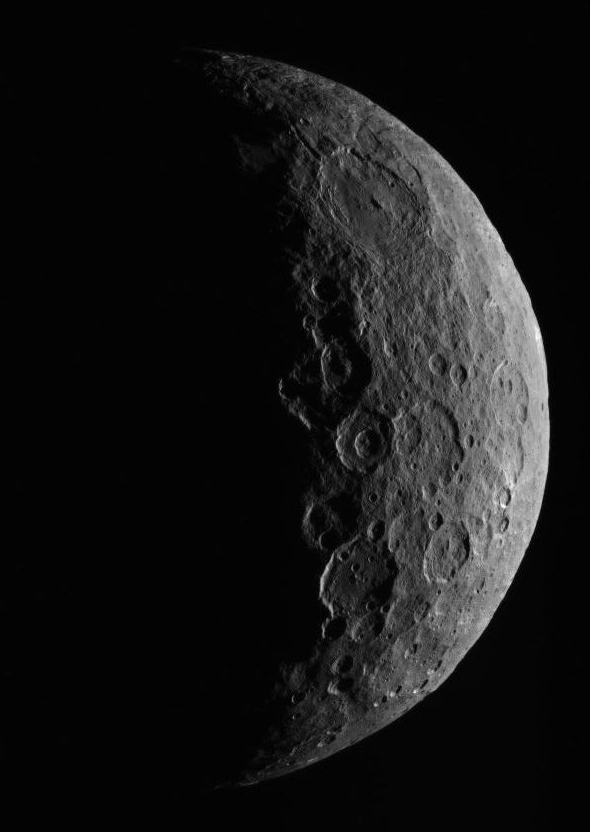
photojournal.jpl.nasa.gov...

photojournal.jpl.nasa.gov...
originally posted by: Ross 54
It's obvious that scientific truth is not decided by a public poll. Never-the-less, I found it interesting, that the JPL thought it fitting to encourage speculation on this matter, on the part of the public.
JPL of course wants public engagement in its missions. This is not the first time they've done a public poll on a mission.
Interesting, too, the way the 'Other' category advanced to the favorite position.
We get a sense of how a portion of the public is reacting to the question of the bright spots on Ceres. It appears that if someone was interested enough to vote in such a poll, they might well have been interested enough to read the conflicting explanations for the bright spots, weigh them, and make a selection.
Such a poll might also be used as a way of gauging the scientific aptitude of the general public. Or at least those who visit the JPL sites.
originally posted by: wildespace
A fantastic new image, as Dawn enters the mapping phase of its Ceres mission:
photojournal.jpl.nasa.gov...
By May 9 the mystery of the spots will probably be solved
originally posted by: data5091
NASA invites the public speculation on what the lights could be. So go ahead and VOTE!!!! Ice which is what I voted for, currently has the lead, but its followed closely by "other."
I chose "Salt Deposit".
Maybe it's a salt flat laid down by water that sublimated away, leaving salt deposits behind.
My second choice would be a frozen deposit of salty/mineraly-rich water (so I suppose "Ice" is my second choice, but I'm talking about water ice with a very very high concentration of mineral salts -- so my true second choice would be somewhere in between "Salt" and "Ice"). Just plain water ice would have a tendency to sublimate away into space rather than being persistent, but maybe if that water was high dissolved mineral salts content, then possibly that salty mineral component is preventing it from sublimating so easily.
edit on 5/3/2015 by Soylent Green Is People because: (no reason given)
By May 9 the mystery of the spots will probably be solved
Interesting conclusion. Looking at the situation with the bright spots on Ceres, I surmise that the question of their nature probably won't be solved by May 9th, or anytime very soon. It will be intriguing to see how this plays out, about a week from now.
edit on 3-5-2015 by Ross
54 because: improved word choice
originally posted by: JadeStar
By May 9 the mystery of the spots will probably be solved
Maybe, maybe not. This first orbital phase (the RC3 orbit) is a very high orbit at 8400 miles (13500 km). That RC3 orbital phase ends May 9, at which time Dawn will spiral closer to Ceres toward it's second science orbit (the Survey orbit), which is still relatively high (2700 miles or 4400 km).
Maybe at that altitude, the scientific instruments on board could possibly do some detailed data collection to help solve the riddle of the bright spots. However, Dawn is scheduled to get even closer to Ceres than that, but not until later this year. Dawn's final orbit will be at only 230 miles (375 km) above Ceres, but that won't happen until December of this year. By that time, maybe the other scientific instruments would have collected enough data to determine what the bright spots are, but that 230 mile orbit will probably yield some great photos.
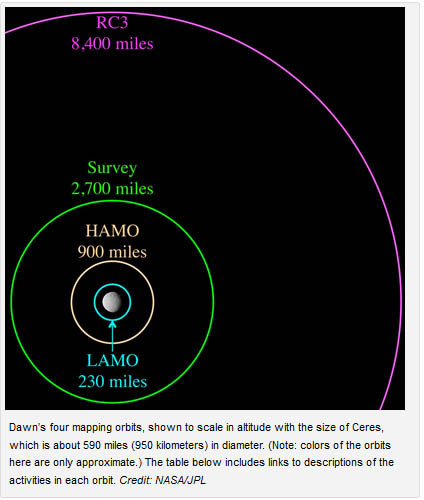
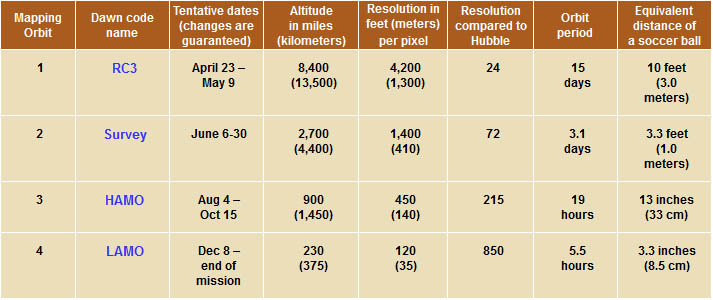
Don't forget to check in with the Unmanned
Spaceflight Forum, which has lots of detailed and techy posts about the mission and its results, as well as some great amateur work with the
images and other data.
Everybody here kinda forgot about Ceres, but there's an exciting new development happening! The Dawn mission people released
a huge pile of images, including those taken through red, green, and blue filters. This allows
anyone to combine them into (more or less) true-colour images of Ceres, pretty much the way you'd see it with your own eyes if you hitched a ride on
the spacecraft: www.planetary.org...
None of these is calibrated color; the balance between channels has been subjectively adjusted until they look "right" to the individual doing the procesing.
Here's one example, by Justin Cowart:
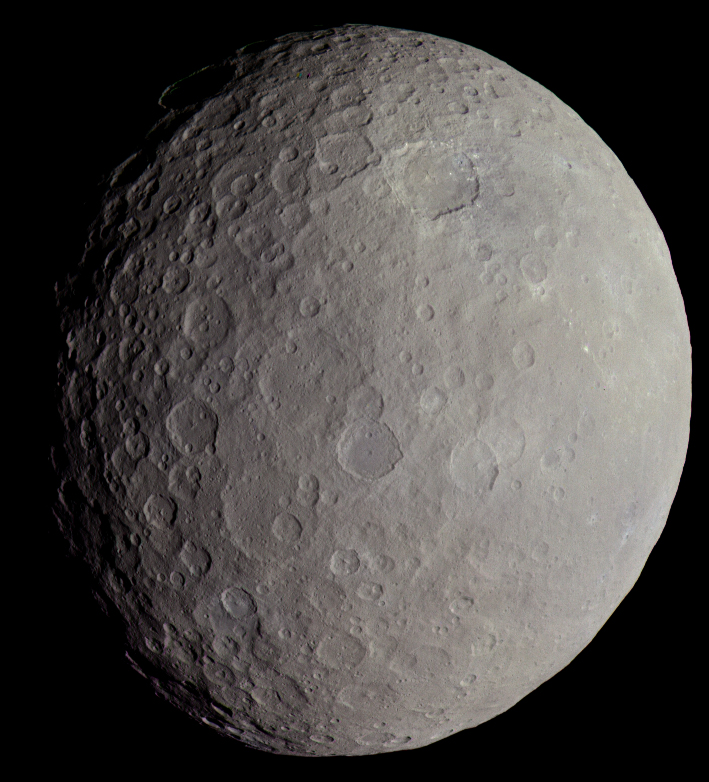
Here's another by the same person:

And here's my own:
(No adjustments; I just combined the channels and tried to align them, although some colour fringing still remains)
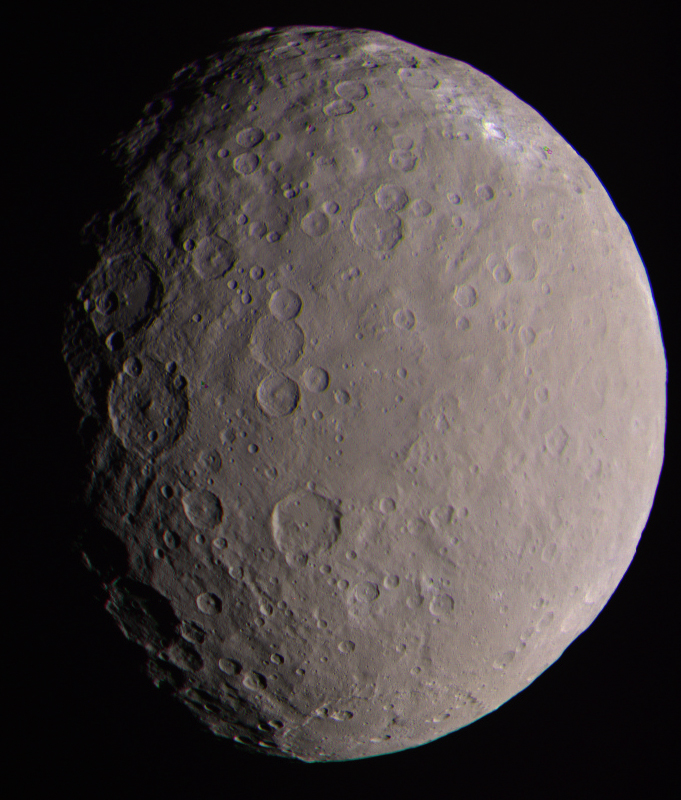
Emily Lakdawalla has very helpfully created a website for easy browsing and viewing of the images, indicating the ones taken through red, green, and blue filters: planetary.s3.amazonaws.com...
None of these is calibrated color; the balance between channels has been subjectively adjusted until they look "right" to the individual doing the procesing.
Here's one example, by Justin Cowart:

Here's another by the same person:

And here's my own:
(No adjustments; I just combined the channels and tried to align them, although some colour fringing still remains)

Emily Lakdawalla has very helpfully created a website for easy browsing and viewing of the images, indicating the ones taken through red, green, and blue filters: planetary.s3.amazonaws.com...
edit on 25-10-2015 by wildespace because: (no reason given)
edit on 25-10-2015 by wildespace because: (no reason
given)
new picture from new orbit!
gosh, people, did you all forget about this? =,(
www.jpl.nasa.gov...
gosh, people, did you all forget about this? =,(
www.jpl.nasa.gov...
edit on 3-12-2015 by egidio88 because: (no reason given)
new topics
-
Electrical tricks for saving money
Education and Media: 1 hours ago -
VP's Secret Service agent brawls with other agents at Andrews
Mainstream News: 2 hours ago -
Sunak spinning the sickness figures
Other Current Events: 3 hours ago -
Nearly 70% Of Americans Want Talks To End War In Ukraine
Political Issues: 3 hours ago -
Late Night with the Devil - a really good unusual modern horror film.
Movies: 5 hours ago -
Cats Used as Live Bait to Train Ferocious Pitbulls in Illegal NYC Dogfighting
Social Issues and Civil Unrest: 6 hours ago -
The Good News According to Jesus - Episode 1
Religion, Faith, And Theology: 8 hours ago -
HORRIBLE !! Russian Soldier Drinking Own Urine To Survive In Battle
World War Three: 10 hours ago
top topics
-
SETI chief says US has no evidence for alien technology. 'And we never have'
Aliens and UFOs: 17 hours ago, 8 flags -
Cats Used as Live Bait to Train Ferocious Pitbulls in Illegal NYC Dogfighting
Social Issues and Civil Unrest: 6 hours ago, 8 flags -
Florida man's trip overseas ends in shock over $143,000 T-Mobile phone bill
Social Issues and Civil Unrest: 13 hours ago, 8 flags -
VP's Secret Service agent brawls with other agents at Andrews
Mainstream News: 2 hours ago, 7 flags -
Former Labour minister Frank Field dies aged 81
People: 15 hours ago, 4 flags -
Bobiverse
Fantasy & Science Fiction: 13 hours ago, 3 flags -
HORRIBLE !! Russian Soldier Drinking Own Urine To Survive In Battle
World War Three: 10 hours ago, 3 flags -
Nearly 70% Of Americans Want Talks To End War In Ukraine
Political Issues: 3 hours ago, 3 flags -
Sunak spinning the sickness figures
Other Current Events: 3 hours ago, 3 flags -
Late Night with the Devil - a really good unusual modern horror film.
Movies: 5 hours ago, 2 flags
active topics
-
HORRIBLE !! Russian Soldier Drinking Own Urine To Survive In Battle
World War Three • 29 • : doubledan717 -
-@TH3WH17ERABB17- -Q- ---TIME TO SHOW THE WORLD--- -Part- --44--
Dissecting Disinformation • 651 • : 777Vader -
VP's Secret Service agent brawls with other agents at Andrews
Mainstream News • 19 • : NoCorruptionAllowed -
VirginOfGrand says hello
Introductions • 5 • : burritocat -
The Reality of the Laser
Military Projects • 44 • : Zaphod58 -
SETI chief says US has no evidence for alien technology. 'And we never have'
Aliens and UFOs • 42 • : Boomer1947 -
NASA Researchers Discover a Parallel Universe That Runs Backwards through Time - Alongside Us
Space Exploration • 71 • : charlyv -
Sunak spinning the sickness figures
Other Current Events • 4 • : annonentity -
Cats Used as Live Bait to Train Ferocious Pitbulls in Illegal NYC Dogfighting
Social Issues and Civil Unrest • 12 • : Hakaiju -
Huge ancient city found in the Amazon.
Ancient & Lost Civilizations • 61 • : Therealbeverage
